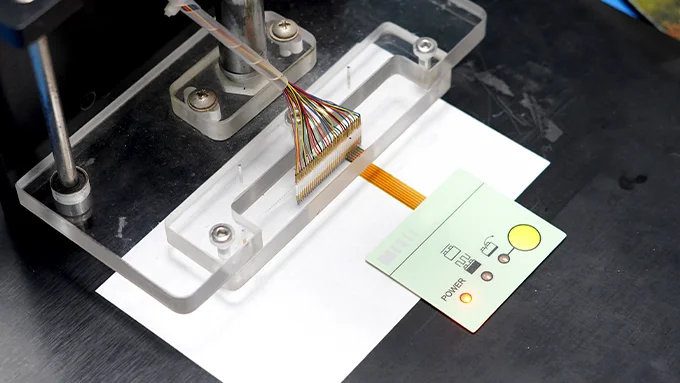The Manufacturing Refine Behind Membrane Switch Over: What You Required to Know
The manufacturing procedure behind membrane changes combines cautious layout, material choice, and quality control. It starts with understanding the ins and outs of membrane layer switch style and advances via various phases, consisting of product choices and printing methods. Each stage plays a crucial duty in ensuring functionality and resilience. Nevertheless, the intricacies of layer building and construction and the strenuous screening standards might disclose understandings that are not right away evident. What exists beyond these foundational components?
Recognizing Membrane Switch Layout
Membrane buttons may show up straightforward at very first glimpse, their style entails complex considerations that guarantee capability and sturdiness. The layout procedure begins with a complete understanding of individual requirements, consisting of the user interface's designated application and ecological elements. Comfort designs is a crucial element, as the layout must facilitate convenience of usage while guaranteeing that tactile feedback satisfies user expectations.Moreover, the layering of components, such as graphic overlays, sticky layers, and conductive traces, need to be precisely crafted. membrane switch. This layered arrangement not only affects the button's responsiveness but additionally impacts its longevity. Focus is offered to the securing techniques utilized to shield against wetness and dirt, which could jeopardize efficiency. In addition, design factors to consider include aesthetic appeals, where color design and aesthetic clearness improve customer experience. Eventually, the style of membrane layer switches equilibriums functionality, user experience, and durability, making certain that they satisfy the demands of various applications efficiently
Materials Used in Membrane Switch Over Production
When picking products for membrane layer switch production, it is necessary to contemplate both efficiency and durability. The key products include polyester and polycarbonate films, which provide adaptability and stamina. These movies are commonly covered with sticky to guarantee correct bonding to substratums. Conductive inks, usually composed of silver or carbon, are essential for developing electrical connections within the switch, allowing for dependable operation.Additionally, a protective layer, such as a tough layer, is often applied to boost scratch resistance and longevity. The option of backing product, such as acrylic or foam, can significantly influence the button's tactile feeling and total individual experience. Various ecological elements, consisting of temperature and humidity, should direct material choice to assure peak efficiency in particular applications. Ultimately, the ideal mix of products contributes to the membrane switch's capability and life-span, making educated options important for suppliers.
The Printing Process: Creating Video and Text
The printing procedure in membrane layer button production plays a considerable function in producing high-grade graphics and message. Different graphic style strategies are employed to ensure visual appeal and capability, while mindful ink selection techniques are essential for sturdiness and efficiency. Understanding these aspects is fundamental for achieving best cause membrane layer button design.
Graphic Style Techniques
Graphic layout strategies play an important function in the printing process of membrane layer switches, as they specify exactly how graphics and message will eventually appear on the end product. Efficient graphic design includes the strategic usage of typefaces, shades, and formats to enhance readability and visual appeal. Designers usually make use of vector graphics for scalability, ensuring that photos continue to be sharp at different dimensions. Additionally, focus to comparison and positioning is vital, as it influences customer interaction and visual high quality. The consolidation of branding aspects, such as logos, must be managed with like keep brand honesty. Generally, thoughtful graphic style methods contribute substantially to the capability and attractiveness of membrane layer buttons, impacting individual experience and product performance.
Ink Selection Approaches
Selecting the suitable ink is important for achieving the preferred visual top quality and sturdiness in membrane switch manufacturing. Various ink kinds are made use of, consisting of solvent-based, water-based, and UV-curable inks. Each type supplies distinct features, such as flexibility, resistance, and bond to environmental factors. Solvent-based inks are commonly favored for their longevity and dynamic shades, while water-based inks are much more ecologically friendly however might have constraints in adhesion. UV-curable inks offer quick treating and durable efficiency. Furthermore, shade matching strategies ensure that the selected inks align with style requirements. Eventually, the option of ink should take into consideration aspects such as application method, substratum compatibility, and end-use requirements to achieve premium outcomes in membrane switch graphics and message.
Layer Building and Assembly

Material Choice Process
A mindful choice of products is vital in the manufacturing procedure of membrane switches, as it directly influences functionality and longevity. The main products utilized consist of polyester, polycarbonate, and numerous conductive inks. Polyester is usually preferred for its exceptional resistance to chemicals and abrasion, making it ideal for harsh atmospheres. Polycarbonate, on the other hand, supplies premium quality and influence resistance, which is useful for applications calling for presence like it and robustness. Conductive inks, commonly made up of silver or carbon, are essential for producing trustworthy electric pathways. Additionally, the choice of glue products affects the total integrity of the button - membrane switch. Examining factors such as environmental exposure, tactile comments, and aesthetic needs overviews suppliers in choosing the most effective products for their particular applications
Layer Bond Techniques
Adhering layers in membrane layer switch building is a crucial process that guarantees capability and long life. Different adhesion techniques are used to safeguard suitable bonding between layers, which commonly consist of the use of adhesives, heat, and pressure. Pressure-sensitive adhesives (PSAs) are typically made use of see page for their convenience of application and prompt bonding capacities. Furthermore, thermal bonding methods can be used, where warmth is made use of to turn on adhesive buildings, safeguarding a strong bond. The option of attachment approach mostly depends upon the materials included and the specific application demands of the membrane button. Correct alignment and consistent application of adhesives are important to protect against defects, securing the button operates successfully throughout its intended lifespan.
Top Quality Control Actions
Ensuring top quality control during the layer construction and assembly of membrane layer buttons is essential for preserving performance and dependability. This procedure normally involves a number of crucial procedures, including detailed evaluations at each stage of manufacturing. Producers make use of advanced testing methods, such as peel examinations and attachment analyses, to confirm the integrity of layer bonds. Additionally, aesthetic assessments are carried out to recognize any flaws in printing or material incongruities. Ecological problems, such as temperature level and moisture, are carefully kept track of to assure perfect treating and attachment. Furthermore, regular calibration of devices helps maintain precise production standards. By executing these quality assurance steps, makers can considerably reduce the danger of item failure, guaranteeing that the last membrane switches fulfill the required specifications and customer expectations.
Evaluating and Top Quality Control Steps

Developments in Membrane Switch Modern Technology
As developments in innovation remain to advance, membrane layer switches are taking advantage of innovative advancements that enhance their functionality and customer experience. One significant innovation is the assimilation of capacitive touch technology, which enables more receptive and instinctive interface. This shift not only improves aesthetics but likewise reduces mechanical damage, extending the life-span of the switches.Additionally, improvements in visuals overlay products have led to enhanced toughness and resistance to ecological elements such as moisture and UV light. These products now provide improved clarity and illumination, additional boosting the aesthetic appeal.Furthermore, the incorporation of wise modern technology is changing membrane switches over right into interactive control panels, allowing connection with IoT tools. This connection fosters a seamless customer experience, leading the means for applications in numerous sectors, from healthcare to customer electronic devices. Collectively, these technologies setting membrane changes as crucial components in modern device style.
Frequently Asked Questions
Exactly how Lengthy Does the Membrane Layer Change Production Refine Take?
The duration of the membrane button manufacturing procedure can differ significantly. Variables such as intricacy, materials made use of, and manufacturing quantity influence timelines, with regular production ranging from a couple of days to several weeks for completion.
What Are the Typical Applications for Membrane Layer Switches?
Membrane layer switches are typically made use of in different sectors, consisting of auto controls, home devices, medical devices, and consumer electronic devices (membrane switch). Their flexibility and durability make them ideal for applications calling for user-friendly user interfaces and reliable performance in varied settings
Can Membrane Changes Be Customized for Particular Requirements?

What Is the Lifespan of a Regular Membrane Layer Switch Over?
The life expectancy of a regular membrane layer switch varies, yet normally, it varies from 1 to 5 million cycles. Elements such as use, environment, and worldly high quality substantially affect sturdiness and total efficiency with time.

Are Membrane Layer Switches Over Ecologically Friendly?
The environmental kindness of membrane layer changes differs. Some materials used might not be recyclable, while others can be green. The general effect depends on producing materials and practices, demanding careful factor to consider during choice and disposal. The production process behind membrane layer changes combines careful layout, material selection, and high quality control. It begins with understanding the ins and outs of membrane layer button style and progresses through various phases, consisting of material selections and printing techniques. When picking materials for membrane button production, it is essential to consider both performance and sturdiness. A cautious choice of materials is vital in the manufacturing process of membrane layer switches, as it directly affects capability and toughness. The choice of attachment method mostly depends on the products entailed and the particular application requirements of the membrane layer button.
Comments on “Is membrane switch consistently withstand harsh industrial environments?”